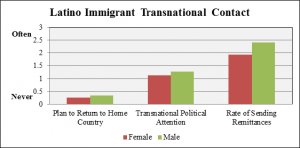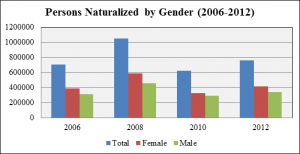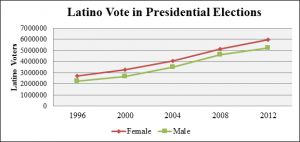With the 2014 midterm elections behind us, we are again reminded of the potential influence of Latino voters. This is because Latinos have had growing political influence in the last couple of presidential elections. We are also reminded of the potential influence of the ‘women’s vote’ in the midterm elections. In this blog I draw your attention to the gender differences in Latino political participation.
Last spring, I began a series of posts on the Latino gender gap in U.S. politics. The first post introduced the phenomenon of gender differences in Latino political attitudes and participation in U.S. politics. My book, The Latino Gender Gap in U.S. Politics, uses national survey and focus group data to highlight and explain the gender shifts in political behaviors and political attitudes of Latinos. I analyze the most recent presidential elections (2004-2012) and find there is a significant gender gap in Latino political attitudes and participation. This second post introduces the key origins of the Latino gender gap, which includes gender differences in Latino immigrant transnational contact and political socialization in the U.S.
First, I explore the role of gender in immigrant contact with their home country. Once Latino immigrants begin to settle in the U.S., they commonly maintain close ties to their families and communities in their home country. Immigrants often engage in transnational contact, which includes emotional, financial, and political connections to their countries of origin. However, researchers often debate whether immigrants’ transnational contact will positively or negatively influence their political participation in the United States. I use the 2006 Latino National Survey (LNS) data to examine the influence of gender on Latino immigrant political behavior, in particular their political attitudes and level of transnational contact.
There is evidence of a gender gap in the Latino immigrant transnational contact and attitudes. Latina immigrants are less likely than Latino male immigrants to maintain close ties with their country of origin, especially for those immigrants who have been in the U.S. for longer periods of time. In particular, Latina immigrants are less likely than Latino males to send remittances (money), pay political attention, or plan to return to their home country. As Latina immigrants spend more time in the U.S., they display less contact with their home country and report an increased desire to remain in the U.S. The varied gendered experiences of the settlement process can bring different attitudes and rates of political participation among Latino men and women in their new host country (Jones-Correa 1998).

One important way that Latina immigrants can more actively participate in their new host country, is through the naturalization process. Female immigrants are generally more likely to naturalize and become citizens of the United States (Office of Immigration Statistics). In particular, Latina immigrants to the United States are more likely than Latino men to pursue naturalization, which points to their increased incentive to take part in their new host country.
This yields greater understanding of the political factors that influence Latina immigrants’ increased political participation in the United States, compared to Latino male immigrants’ increased attention to their home country politics.

In addition, I explore the gender differences in Latino civic and electoral participation in the United States, which I argue is influenced by their divergent political socialization and life experiences. Latino youth have gendered experiences of political socialization, which can lead to different views and rates of political involvement. For example, young Latinas are socialized to take on more community involvement and increased responsibility within their families, as a factor of traditional gender roles, compared to young Latino males (Lopez 2003). This can lead to Latinas developing more civic skills and showing higher rates of political involvement than Latino males. In particular, Latinas have higher voter turnout rates in presidential elections, than Latino males (NALEO; U.S. Census Bureau CPS).

Latinas’ increased political participation can also provide them with stronger ties to their community and political institutions. Latinas are especially motivated to get involved in their communities, when there is an issue of importance at stake. Latinas are likely to take the initiative and personally organize their communities. As a result, Latinas are often viewed as the key connection with the Latino community.
The subsequent posts in the series focus on the gender differences in Latino public policy views, political partisanship, and the political implications of the gender gap. The results emphasize the central role of Latinas’ increased participation in politics, which is redefining our assumptions about future Latino political participation in the U.S.
Christina Bejarano is an Associate Professor of Political Science at the University of Kansas. Her book entitled The Latino Gender Gap in U.S. Politics (2014) was published by Routledge Press.


